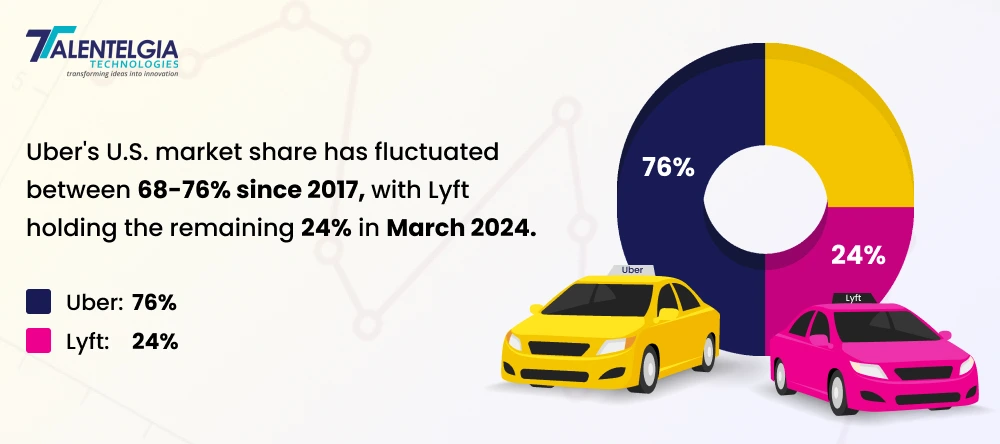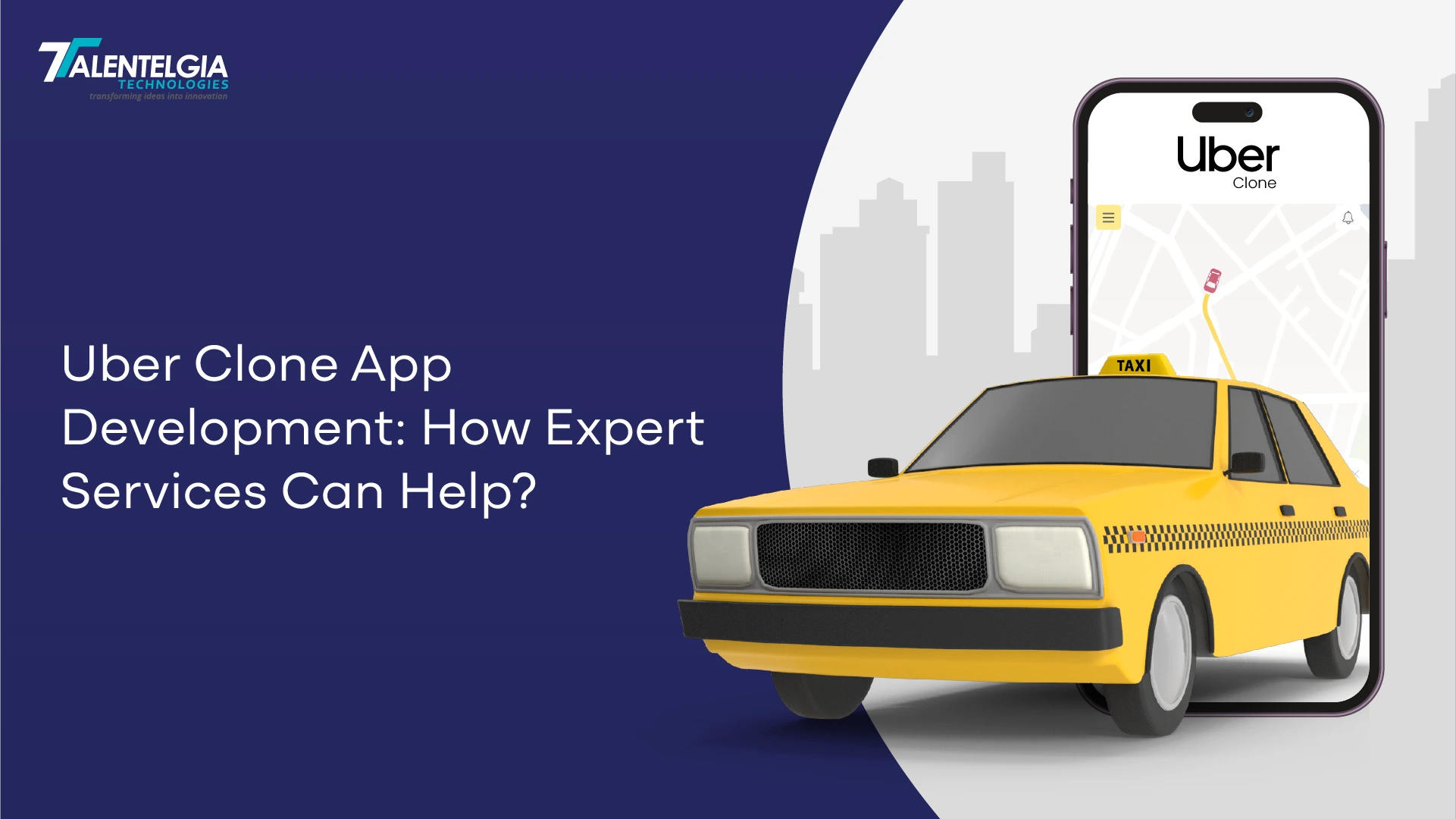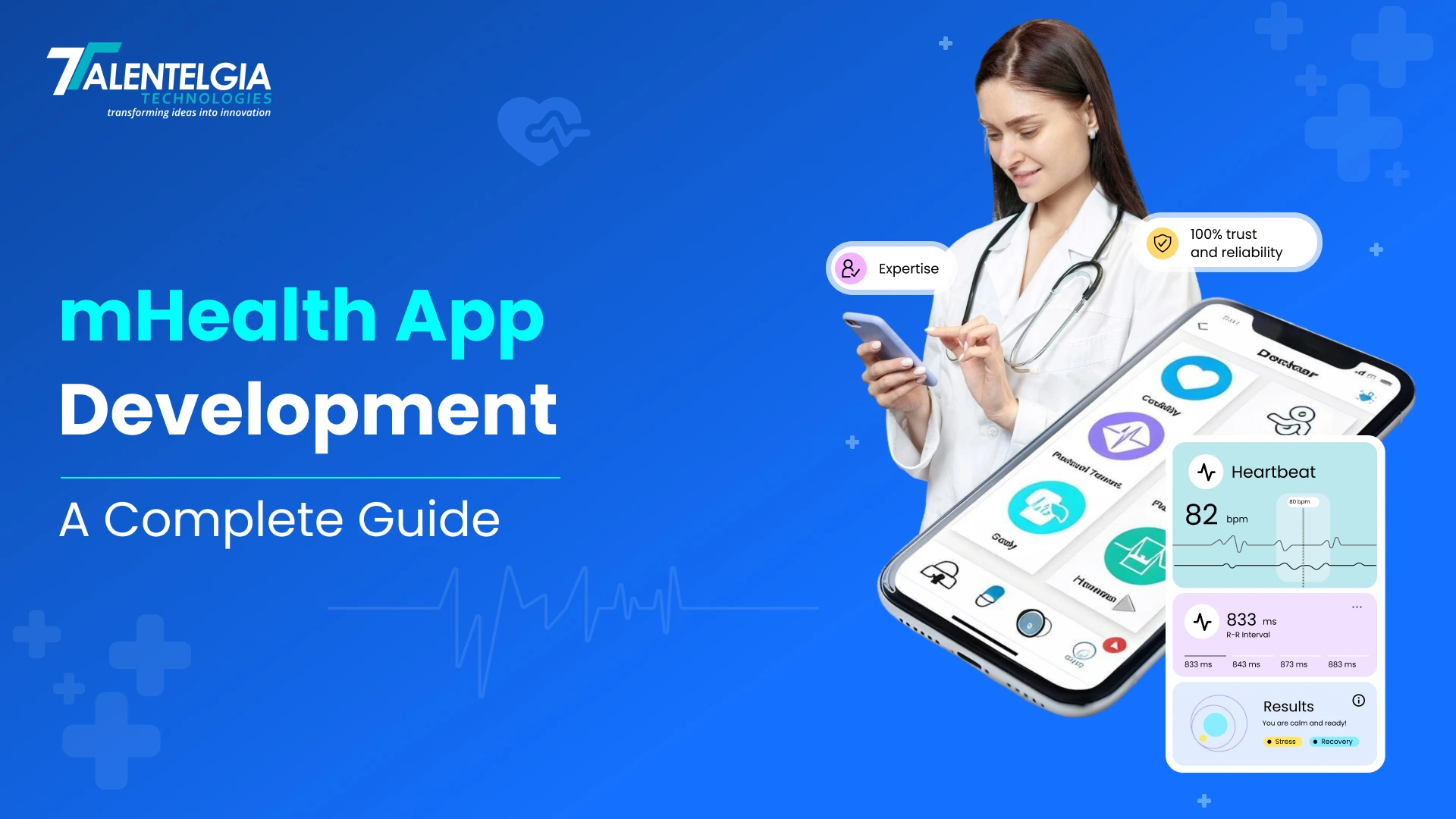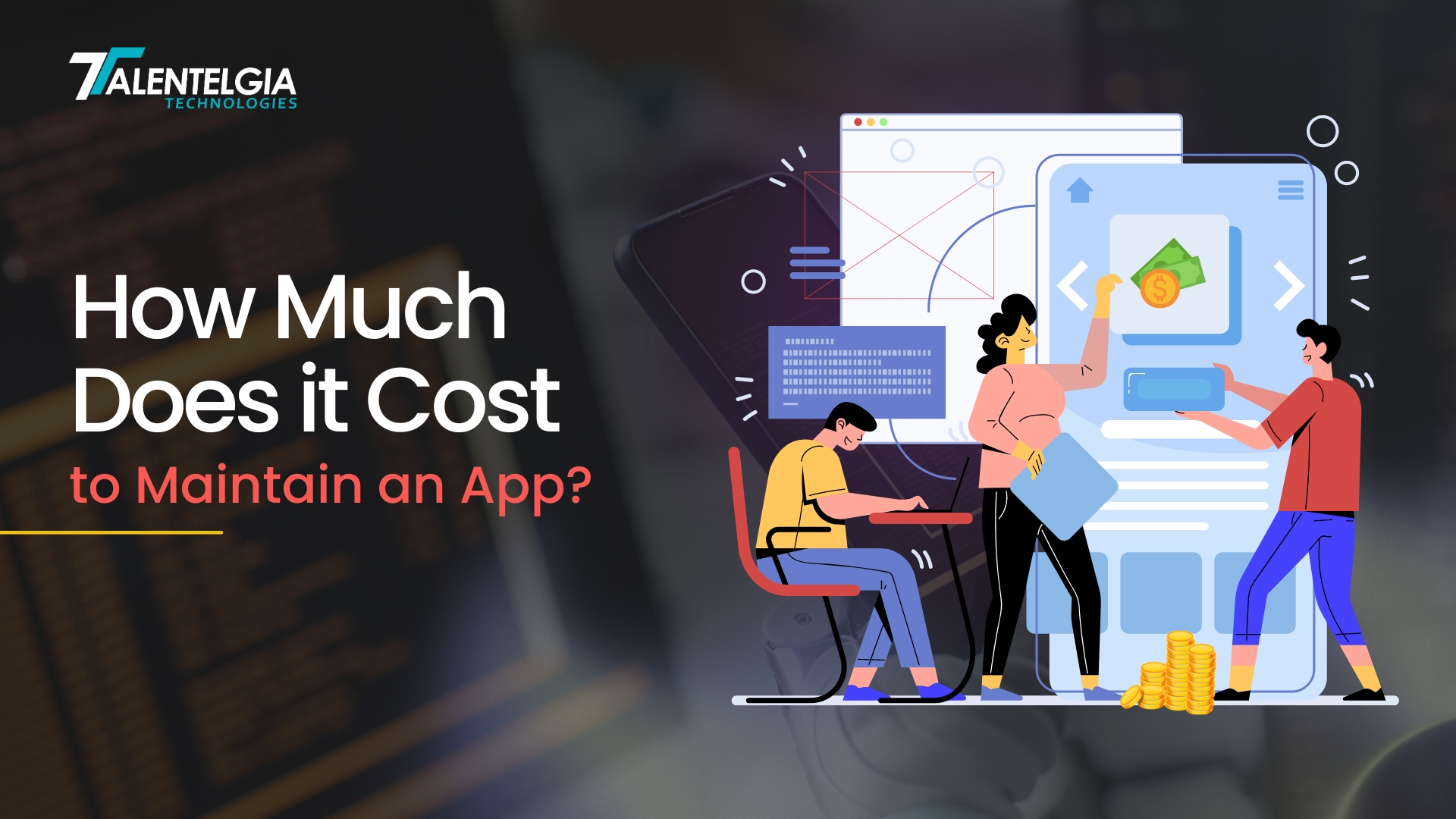Online taxi booking and ride-sharing apps are transforming the industry by offering convenience to modern users. This explains the rise in Uber clone app development among entrepreneurs. Uber clone apps provide an opportunity to develop models for targeted audiences and their geographical locations.
Moreover, Uber clone app development is not just about copying the already available famous Uber model. Instead, it’s more about designing a scalable and feature-rich platform to match today’s needs. Be it the ride-booking option or real-time tracking to seamless payments, there is no end to possibilities.
If you are also looking for a reliable Uber clone app development company, our experts are here to help. Read to find out more about Uber clone scripts, their benefits, and features!
Key Takeaways:
- The market for Uber clone apps is growing. The success of Uber clone app development has encouraged several ride-hailing applications, each with unique features and target markets.
- AI in ride-hailing: Dynamic pricing, intelligent driver matching, and personalized recommendations are among many AI-powered features that make user experience frictionless and guarantee smooth and seamless operations for the company in question.
- Uber clone app development has to be phased, starting with an MVP and progressing toward advanced feature inclusions.
- Using open-source frameworks and/or seeking help from a team of experts specializing in AI: The tools are available, like TensorFlow, to help; seeking help will quicken the pace of development and ensure that AI is used optimally.
- Cost considerations are high: the complexity of the features, selection of the platform, integration of AI, and expertise of the development team drive up the cost of development considerably.
- Regular updates: Changes according to user feedback and market trends, are important for staying competitive and ensuring long-term success.
How AI Adds to the Capabilities of Uber Clone Development?
The global market for ride-sharing was estimated at US$113.2 Billion in 2023 and is projected to reach US$305.3 Billion by 2030, growing at a CAGR of 15.2% from 2023 to 2030.
AI has become a powerful technology that is changing the way businesses function and interact with customers. AI integration into the Uber clone app development process enables a business to manage its operations efficiently. This offers better customer satisfaction and helps them stay ahead of the competition.
AI allows these apps to offer advanced features like dynamic pricing, driver assignment, and personal recommendations with unmatched speed and accuracy. AI automation ensures sharper, quicker, and more trustworthy services for customers and drivers.
Let’s find out how AI integration services for these apps improve the functionalities and performance of Uber clone apps.
AI Virtual Assistant
With the power of AI-driven virtual assistants, the handling of customers will take a new turn. AI-enhanced chatbots and live support tools let your Uber clone app provide real-time responses, query handling, and personalized recommendations.
AI-Driven Personalization Engine
User behavior, preference, and location-analyzing AI-driven personalization delivers customized search results. The ensures an interactive user experience with automated notifications on push alerts, SMS, and email to keep the users informed.
AI-Optimized Dynamic Pricing
AI algorithms analyze demand, location, weather, and traffic in real time to develop a dynamic pricing model. This ensures that the pricing for customers is fair while drivers also earn maximum amounts and balance affordability and profitability.
Intelligent Driver Matching
AI enables driver matching to be smarter, considering proximity, route efficiency, and driver ratings. This minimizes wait times for the passenger and can optimize drivers’ schedules to achieve better productivity and customer satisfaction.
Key Features in Robust Uber Clone App Development
| Feature | User | Driver | Admin |
|---|---|---|---|
| Account & Profile | Account Creation & Login Profile Management (Personal Info, Payment) Address BookRide Preferences Contact Support | Driver Registration & Verification Vehicle Information & Documentation Profile Management Availability Status Contact Support | User & Driver Management Role-Based Access Control User/Driver Verification & Approval Dashboard & Analytics |
| Ride Booking | Real-time Ride Requests Ride Scheduling Fare Estimation Live Ride Tracking Ride History Fare Splitting (if applicable) | Book/Receive & Accept/Decline Requests booking Navigation & Route Optimization booking ETA & Arrival Notifications booking Contact Rider booking View Trip Details | Booking Monitor Ride Requests & Dispatches Booking Track Driver Locations booking Manage Surge Pricing Booking Generate Reports (Ride Volume, Earnings) |
| Payment & Transactions | Multiple Payment Options In-App Payments Receipt Generation Payment History & Receipts | Booking View Earnings Booking Track Payment History Booking Receive Payouts booking Manage Payment Preferences | Booking Manage Payment Gateways Booking Process Payments & Withdrawals booking Commission Management booking Financial Reports |
| Communication & Safety | In-App Chat with Driver Emergency Contacts SOS Button Driver Ratings & Reviews | Booking In-App Chat with Rider booking Emergency Contacts Booking Driver Ratings & Reviews booking Safety Training (optional) | Booking Monitor Safety Incidents Booking Implement Safety Measures (Background Checks) Booking Manage Fraud Detection booking Communication with Users/Drivers |
While building a competitive and user-friendly Uber clone app, it’s important to carefully incorporate the features. These should be beneficial for riders and drivers, assuring them of convenience, safety, and efficiency. Every feature needs to be user-oriented, assuring ease of functionality while making sure reliability comes along. The below features can help make your idea stand out when you are working on Uber clone app development.
1. User and Driver Profiles
Personalization of experiences through user and driver profiles forms the backbone of any ride-booking application. It is the very foundation of Uber clone app development. This ensures that the services offered are tailored to the needs of both riders and drivers. Profiles build trust, ease the process, and facilitate smooth communication between both parties. This gives a personalized experience that keeps them loyal and satisfied.
- User Profiles: The personalization of ride-booking is based on user profiles. This allows passengers to manage vital information like personal information, saved addresses, and payment preferences.
- Driver Profiles: The driver profile enables a professional site for the driver to update their availability, earnings, and areas for service improvement. It works towards the development of trust and credibility among passengers.
2. Real-time GPS Tracking
This feature lets passengers trace their rides in real-time and keeps them informed about their journey. For drivers, GPS tracking ensures they can navigate efficiently, reducing travel time and fuel costs.
- Users can view the live location of their driver before and during the ride.
- Drivers can have optimized routes considering the traffic conditions and proximity to the destination.
- Admins can make use of this feature for tracking the fleet’s movement and analyzing the bottlenecks in services.
Advanced Capabilities: Geofencing integrated with route optimization and traffic analysis enhances the accuracy and reliability of GPS tracking. This makes the Uber clone app development more user-centric and effective.
3. Payment Integration
A smooth and flexible payment system is crucial to the success of a ride-hailing app. A wide range of payment options lets the application target more customers and also makes the checkout process much easier. A seamless payment increases user experience by reducing friction in payments. They also ensure that drivers are paid on time, which in turn builds their trust in the platform.
- Integrate multiple payment methods, such as credit/debit cards, mobile wallets, and cash on delivery.
- Let the system calculate the fare automatically to avoid any disputes or miscommunication regarding the price.
- The system should be able to split the fare when the ride is on sharing and provide receipts for record-keeping purposes.
- Security Features: Secure gateways for safe transactions, two-factor authentication to verify users, and fraud detection mechanisms.
4. Ride Scheduling
Convenience means the ability to schedule a ride in advance for planned trips. Scheduled rides take away last-minute stress from the users and give drivers predictable bookings.
- Riders can select specific dates, times, and pick-up locations for their journeys.
- Reminders via the app will be sent to the users and drivers for timely execution.
- Admins can monitor the scheduled rides to optimize fleet allocation and avoid any delays to the service.
- Allow for recurring bookings for daily commutes or corporate travel, offering built-in features to enhance user engagement.
5. Rating and Reviews
Feedback mechanisms in terms of ratings and reviews are important for maintaining quality services in Uber clone app development. Ratings serve the purpose of accountability and trust. So customers and drivers would rate each other based on their experience:
- Riders can rate their trips and give feedback on aspects such as punctuality, ride comfort, and driver behavior.
- Drivers can rate the passengers for mutual respect and safety.
- Admins can use aggregated ratings to reward top-performing drivers or address user complaints promptly.
Benefits to Stakeholders: This feature ensures continuous improvement in service quality, enhancing user satisfaction and retention.
6. Advanced Features
Advanced features like AI-based recommendations and heatmaps for drivers, make the Uber clone app development more competitive.
- AI-Based Recommendations: Machine learning for suggestions of ride preferences, promotions, or frequently used destinations based on user behavior.
- Heat Maps for Drivers: The areas of high demand are indicated to help drivers position themselves for maximum earnings.
- Predictive analysis: Analyzing surge pricing for better operational efficiency and revenue generation.
These features, work toward creating an end-to-end Uber clone app, competitive and suits modern users’ expectations.
Also Read: How To Start A Taxi Business?
How Uber Clone App Development Works?
The development of a successful Uber-like ride-booking application is to be done methodically. This app development process includes a phase-by-phase development based on an incomplete functional core to a more sophisticated inclusion of AI. A developer can also use open-source frameworks to make a robust competitive platform. However, the long-term success of an Uber clone app development project will depend on user feedback and changes in market trends.
1. MVP Development
Develop the (MVP) minimum viable version of the app. This contains only the most important features such as user sign-up and log-in, and onboarding of drivers. It focuses on basic functionality for raising a request for a ride – pick-up/drop-off – and a simple payment mechanism.
2. Integration of Core AI Capabilities
Gradually introduce the basic AI features: basic route optimization including real-time traffic data. Also, focus on basic surge pricing mechanisms based on demand, and a basic matching mechanism between riders and available drivers.
3. Open-Source AI Frameworks and Partner with Experts
Utilize readily available and powerful open-source AI frameworks like TensorFlow or OpenAI. These frameworks provide pre-built models and tools for tasks like route optimization, demand forecasting, and fraud detection. Collaborate with experienced developers or agencies specializing in AI integration for ride-booking applications to accelerate development and ensure optimal AI implementation.
Also Read: Top AI Frameworks & Libraries.
4. Continuous Improvement and Refinement
Continuously upgrade the application to the next level with user feedback and market trends. Introduce advanced AI features: dynamic pricing based on various factors like time, weather, events; predictive maintenance of vehicles; and sophisticated fraud detection mechanisms. Regularly update and enhance the AI models of the application for optimized performance, matching the dynamic nature of users’ needs.
This means the development will be structured and iterative. This also allows for a gradual introduction of AI capabilities in an app that keeps improving its functionality.
Cost of AI-Powered Uber Clone App Development

Uber clone app development requires investment and strategy, as advanced features and integrations cost more. The final cost of Uber clone app development depends on multiple factors like functionality, platform, design complexity, and the proficiency of the team. The various elements of making an AI-integrated Uber clone app are listed below.
1. Feature Complexity
The Uber clone app development process is much influenced by the scope and sophistication of features. While basic functionality for ride-booking is necessary, incorporating advanced AI-driven features such as:
- Dynamic Pricing: Fares dynamically change based on demand, traffic, and weather conditions.
- AI-Driven Matching: Riders are matched with drivers by algorithms that work out the best proximity, availability, and efficiency.
- Predictive Analytics: AI-powered forecasts of demand patterns to optimize resource allocation.
- Personalization Engine: Provides personalized suggestions, paths, and notifications, depending on user behavior and preference.
The higher the bar set for AI, the higher the cost of developing it.
2. Selection of Platform
Before you start working on Uber clone app development, it is important to understand your user’s demographic. This will help you make the right decisions your app’s running platform makes quite a difference in development cost:
- Single Platform Development (iOS or Android): Lowering the expense, but restricts the reach to just one type.
- Cross-platform development with Flutter and React Native enables broader reach with a possibly greater upfront cost.
3. Back-end Development and Integration of AI
The high load of real-time data processing, complex calculations of AI, and interaction with users require a powerful backend. It would take some time and expertise to integrate AI tools and frameworks such as TensorFlow, PyTorch, or Google AI. Besides, cloud infrastructure for scalable AI functionalities also adds up to the cost.
4. App Design
User experience is an important part of the uber clone app development process. Further, user retention requires an effortless UX and beautiful UI. The cost increases with intricacy in design, engaging interfaces, and AI functionalities, such as voice commands.
5. Expertise in Development Team
Expertise and location are yet other important contributors to considerations in your development team:
- Freelancers: cheaper but lacking the cohesive expertise required for the more advanced AI features.
- Development Agencies: Will provide experienced professionals in AI and app development, though at a higher cost.
- In-House Team: Provides control, but requires investing in hiring, training, and infrastructure.
6. Testing and Quality Assurance (QA)
Functionalities of AI will require extensive testing to get accurate and reliable results. Applications requiring real-time data use involve extensive QA services for server overload, incorrect matches, or payment failure.
7. Post-Launch Support and Updates
Uber clone app development is an ongoing process. The launch is just the beginning. The updating and maintenance over time, including the addition of new AI features, will also go on to incur further costs.
Estimated Cost Range
Though the costs vary based on the above-mentioned factors, here is a basic breakdown:
- Simple App Development: $20,000-$50,000 (Basic features without advanced AI included).
- AI-powered Uber Clone App: $50,000-$150,000 (Includes AI-enabled dynamic pricing, predictive analytics, driver matching, etc.).
- Premium Customized Solution: $150,000+ (Advanced AI, multi-platform compatibility, high-level design).
Most Popular – Examples for Uber Clone Apps Development
The success of Uber has increased the demand for ride-booking applications following its model. They have been termed “Uber clones.” These sites use similar core features, such as location tracking in real-time, dynamic pricing algorithms, and secure payment gateways. Successful Uber clone app development companies differentiate their offer by integrating the latest technological advances.
Many high-performing Uber clone apps have flourished because of the success of Uber. Each of these platforms has found its niche by offering tailored services and innovative features.
1. Lyft – This is an app that is easy to use and safe, making it a major competitor in the ride-sharing space.
2. Ola– Ola is very popular in Asia, with options from the cheapest auto to a luxury car.
3. Bolt– It serves Europe and Africa on an affordable basis, quickly booking ride services.
4. DiDi – This is China’s market leader, combining all means of transportation under one application.
5. Grab– Widely used in Southeast Asia, it assembles ride-booking together with food delivery and financial services.
These apps show how versatile and scalable Uber clone app development could be, indicating that this is an open field to grow in.
Uber Clone App Development Market Size: A Growing Industry
The ride-hailing market is growing explosively, driven by increasing urbanization, technological advancements, and changing consumer preferences. This surge has increased the demand for Uber clone app development among entrepreneurs.
Growth Market: According to Statista’s estimation, this industry will increase several folds in value. The driving factors include growing smartphone users, urbanized masses increasing day by day, and gig economies amongst others, which are expected to balloon the industry.
This could turn out to be an opportunity for businesses and entrepreneurs seeking to enter the on-demand transportation sector.
Key Drivers of Growth in the Market
The constant evolution of technologies in AI, machine learning, and IoT is a great driver for innovation in ride-hailing. Besides, rapid urbanization-when people move to the cities-impacts demand for relatively inexpensive transport services. This explains a surge in Uber clone app development, as it depends on different factors like:
- Changes in consumer behavior: Modern customers get used to acquiring on-demand services. They look for convenience, flexibility, and personalized experience.
- Competitive industry: The ride-hailing market has turned out to be competitive, with many established and new players in the industry. This requires continuous innovation and solid customer focus for one to have a competitive advantage.
Challenges and opportunities will be there for the enterprises entering to serve ride-hailing in this dynamic market environment. Therefore, integrating technology, addressing customer needs, and adapting to the evolving market landscape, will help entrepreneurs in Uber clone development.
Why Do You Need an Uber Clone App Development Services?
An Uber clone app will be a great opportunity for entrepreneurs in the growing on-demand transportation industry. Thus, one can enter into a proven business model and modify features where needed to target specific markets.
An Uber clone app development project allows for targeting niche corporate clients, ride-pooling users, or eco-friendly commuters. By using advanced technologies, one can introduce features. These include electric vehicle support, ride subscriptions, and automated dispatch systems in business offerings.
In addition, the scalability of Uber clone app development also ensures long-term growth potential. With ride-booking services becoming an integral part of urban living, investing in Uber clone app development can offer a competitive advantage. If you are also planning to start working on Uber clone app development, our team can help you with
- Uber clone script
- Uber clone app source code
- Best Uber clone app for Android (APK)/ iOS
- Uber clone app development services
- Taxi booking app development services
Also Read: How to Develop a Food Delivery App
Conclusion
Going for Uber clone app development is an excellent way to enter the thriving ride-booking market. The right strategy helps businesses develop feature-rich and user-friendly platforms that attract and retain customers. Starting from market research and interface designing, it involves optimizing performance, marketing, and much more in Uber clone app development.
Other examples such as Lyft, Ola, and Bolt confirm the success potential of the Uber clone app development. Even if targeting special groups of clients or relying on some of the advanced new features. Developing the Uber clone app brings more scope for a business to raise demands and enhance the customer experience in this progressing space.


 Healthcare App Development Services
Healthcare App Development Services
 Real Estate Web Development Services
Real Estate Web Development Services
 E-Commerce App Development Services
E-Commerce App Development Services E-Commerce Web Development Services
E-Commerce Web Development Services Blockchain E-commerce Development Company
Blockchain E-commerce Development Company
 Fintech App Development Services
Fintech App Development Services Fintech Web Development
Fintech Web Development Blockchain Fintech Development Company
Blockchain Fintech Development Company
 E-Learning App Development Services
E-Learning App Development Services
 Restaurant App Development Company
Restaurant App Development Company
 Mobile Game Development Company
Mobile Game Development Company
 Travel App Development Company
Travel App Development Company
 Automotive Web Design
Automotive Web Design
 AI Traffic Management System
AI Traffic Management System
 AI Inventory Management Software
AI Inventory Management Software
 AI Software Development
AI Software Development  AI Development Company
AI Development Company  AI App Development Services
AI App Development Services  ChatGPT integration services
ChatGPT integration services  AI Integration Services
AI Integration Services  Generative AI Development Services
Generative AI Development Services  Natural Language Processing Company
Natural Language Processing Company Machine Learning Development
Machine Learning Development  Machine learning consulting services
Machine learning consulting services  Blockchain Development
Blockchain Development  Blockchain Software Development
Blockchain Software Development  Smart Contract Development Company
Smart Contract Development Company  NFT Marketplace Development Services
NFT Marketplace Development Services  Asset Tokenization Company
Asset Tokenization Company DeFi Wallet Development Company
DeFi Wallet Development Company Mobile App Development
Mobile App Development  IOS App Development
IOS App Development  Android App Development
Android App Development  Cross-Platform App Development
Cross-Platform App Development  Augmented Reality (AR) App Development
Augmented Reality (AR) App Development  Virtual Reality (VR) App Development
Virtual Reality (VR) App Development  Web App Development
Web App Development  SaaS App Development
SaaS App Development Flutter
Flutter  React Native
React Native  Swift (IOS)
Swift (IOS)  Kotlin (Android)
Kotlin (Android)  Mean Stack Development
Mean Stack Development  AngularJS Development
AngularJS Development  MongoDB Development
MongoDB Development  Nodejs Development
Nodejs Development  Database Development
Database Development Ruby on Rails Development
Ruby on Rails Development Expressjs Development
Expressjs Development  Full Stack Development
Full Stack Development  Web Development Services
Web Development Services  Laravel Development
Laravel Development  LAMP Development
LAMP Development  Custom PHP Development
Custom PHP Development  .Net Development
.Net Development  User Experience Design Services
User Experience Design Services  User Interface Design Services
User Interface Design Services  Automated Testing
Automated Testing  Manual Testing
Manual Testing  Digital Marketing Services
Digital Marketing Services 
 Ride-Sharing And Taxi Services
Ride-Sharing And Taxi Services Food Delivery Services
Food Delivery Services Grocery Delivery Services
Grocery Delivery Services Transportation And Logistics
Transportation And Logistics Car Wash App
Car Wash App Home Services App
Home Services App ERP Development Services
ERP Development Services CMS Development Services
CMS Development Services LMS Development
LMS Development CRM Development
CRM Development DevOps Development Services
DevOps Development Services AI Business Solutions
AI Business Solutions AI Cloud Solutions
AI Cloud Solutions AI Chatbot Development
AI Chatbot Development API Development
API Development Blockchain Product Development
Blockchain Product Development Cryptocurrency Wallet Development
Cryptocurrency Wallet Development About Talentelgia
About Talentelgia  Our Team
Our Team  Our Culture
Our Culture 
 Healthcare App Development Services
Healthcare App Development Services Real Estate Web Development Services
Real Estate Web Development Services E-Commerce App Development Services
E-Commerce App Development Services E-Commerce Web Development Services
E-Commerce Web Development Services Blockchain E-commerce
Development Company
Blockchain E-commerce
Development Company Fintech App Development Services
Fintech App Development Services Finance Web Development
Finance Web Development Blockchain Fintech
Development Company
Blockchain Fintech
Development Company E-Learning App Development Services
E-Learning App Development Services Restaurant App Development Company
Restaurant App Development Company Mobile Game Development Company
Mobile Game Development Company Travel App Development Company
Travel App Development Company Automotive Web Design
Automotive Web Design AI Traffic Management System
AI Traffic Management System AI Inventory Management Software
AI Inventory Management Software AI Software Development
AI Software Development AI Development Company
AI Development Company ChatGPT integration services
ChatGPT integration services AI Integration Services
AI Integration Services Machine Learning Development
Machine Learning Development Machine learning consulting services
Machine learning consulting services Blockchain Development
Blockchain Development Blockchain Software Development
Blockchain Software Development Smart contract development company
Smart contract development company NFT marketplace development services
NFT marketplace development services IOS App Development
IOS App Development Android App Development
Android App Development Cross-Platform App Development
Cross-Platform App Development Augmented Reality (AR) App
Development
Augmented Reality (AR) App
Development Virtual Reality (VR) App Development
Virtual Reality (VR) App Development Web App Development
Web App Development Flutter
Flutter React
Native
React
Native Swift
(IOS)
Swift
(IOS) Kotlin (Android)
Kotlin (Android) MEAN Stack Development
MEAN Stack Development AngularJS Development
AngularJS Development MongoDB Development
MongoDB Development Nodejs Development
Nodejs Development Database development services
Database development services Ruby on Rails Development services
Ruby on Rails Development services Expressjs Development
Expressjs Development Full Stack Development
Full Stack Development Web Development Services
Web Development Services Laravel Development
Laravel Development LAMP
Development
LAMP
Development Custom PHP Development
Custom PHP Development User Experience Design Services
User Experience Design Services User Interface Design Services
User Interface Design Services Automated Testing
Automated Testing Manual
Testing
Manual
Testing About Talentelgia
About Talentelgia Our Team
Our Team Our Culture
Our Culture

















 Write us on:
Write us on:  Business queries:
Business queries:  HR:
HR: 




